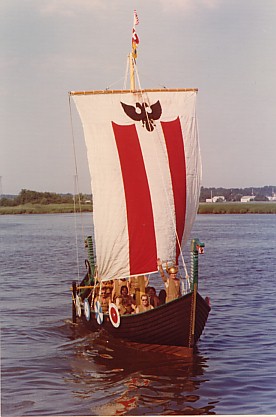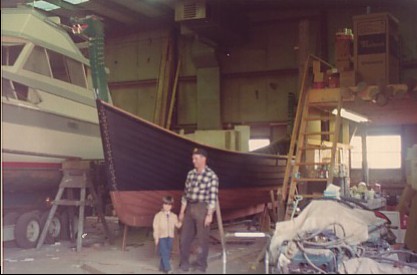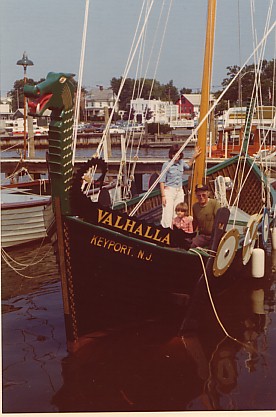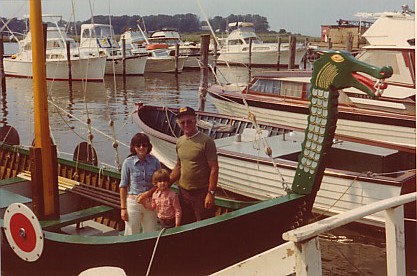It all began with the birth of Hans Pedersen on Oct. 5 1896. He was the second son born to Jens Peder Pedersen and Katrina Pedersen. Preceding him was Jens Peder, and following him was August. There were also four girls. They were all born on the family farm in Griese, Jutland, the main part of Denmark. All the boys worked on the family farm and also on the neighbors’ farms. Peter became a carriage maker, and August, a millwright. Hans served his apprenticeship time and became a cabinet maker. I remember him telling me that his final test to become a journeyman was to take a pile of rough lumber, dress it down and build a chest of drawers, and that the drawers had to fit so tight that when one drawer was closed the other would open from air pressure. That was the mark of a craftsman. All the boys served their mandatory one year in the Danish Army. Hans obtained work, first as a casket maker and then as a cabinet maker. I remember him telling me that as a casket maker, part of the job was to pick up the bodies, and that part of the job he did not like.
In 1918 he met and married Kirsten Marie Dalsgaard. She was the daughter of a dairy farmer. Anne was the first child born, then Erik, Ella, Ejvin (Ivan), and finally Greta. At one time the family moved to Copenhagen where Hans and Kirsten operated a butcher shop owned by Kirsten’s sister and her husband. While in Copenhagen Hans also worked in a shipyard as a cabinet maker. They did not care for city life so they moved back to rural Denmark and settled in Vejle, where the last of their children were born.
August had emigrated to the U.S. in early 1917, so Hans and Peter also applied to emigrate, and Hans left in January 1918. It was a very cold winter and I remember hearing and seeing pictures of their ship frozen in the ice for a short time. Hans obtained work in the Perth Amboy area at first and then in Humphries shipyard in Keyport. The yard was engaged in building custom yachts. They had a 110 foot yacht under construction.
The rest of the family arrived on Dec 28, 1929, and moved into a house in Keyport. Anne and Erik started school. All was well for a while but then the great depression took effect. Humphries Shipyard suspended operations and Hans lost his job, along with millions of others. He had to move his family to a cheaper house and it was very difficult to earn a living. Hans always managed to put food on the table. He worked at various jobs, painting houses, etc.. Once he worked in a box factory in Matawan for 35 cents an hour, and walked to work to save the price of bus fare. We had no car, telephone, or even a radio. In 1934 a friend who owned a bar and restaurant and boat livery wanted a boat built, so Hans agreed to build it. He rented space in the Humphries boat yard to build the boat. The hull was nearly done when a rich young man came along and wanted to buy it to install a Hispano Suiza aircraft engine in it. The original purchaser (Mister Stalder) agreed, for a price, to wait for another boat to be built. Then Hans rented a small building on Second Street in Keyport. It was next to a pajama factory and near a railroad spur. Then financially things got better. Orders kept coming in and the business was growing. At first Hans did not have any power tools, not even an electric drills. He sawed all the planks and bored all the holes by hand. Finally he purchased some power tools and things were a little easier.
In 1935-36 he was contacted by a man named Roxy, who owed a marina and boat livery in Highlands. He wanted several boats built to tow his rowboats out to the fishing grounds in Sandy Hook Bay. Hans agreed to build them and the result was that seven boats were built for Roxy, including a 40 foot Head boat and 2 charter boats. The boats were all named Flash. He also built other boats; a lot of them were for policemen and city firemen, who had steady jobs. His brother August worked for him, and also his son-in-law to be, Andy Ulrichsen. In 1938 he moved to a large building on the waterfront in Keyport. He rented the property where Olsen’s boatyard is now. The boats got bigger and fancier and all was going great. There was no problem selling boats, only producing them. Hans had a work force of up to ten people. I, his son Erik, was working with him and learning the trade. He was a hard taskmaster: there was only one way to do it and that was the right way. All was going well but war was eminent. In 1940 Hans received an order for ten 26 foot boats from Roxy. He had the first ideas for U drives. He intended to put the whole front end of model A Ford engine, steering and all, in the boats.That way they would be easy to operate. Unfortunately, the war came along and the hurricane of 1944 ruined Roxy’s marina, also the Pedersen yard. Hans had already made some of the parts for the boats. I remember them lying around for some years.
Because of the preparations for war, materials for private boatbuilding were becoming scarce. Hans was offered an opportunity to bid on a goverment contract to build some boats that he very easily could build. He was all ready to do this when he found out that it involved some paybacks to some people. He was a citizen and very patriotic and refused to do this, so he did not get the contract. As a result he suspended operations and went to work for Jennings’ Boatyard in Keasby, N.J. His brother August and I, and his son-in-law to be, Howard Wilson, also worked there. We were building 36 foot re-arming boats for the Army Air Force. They were used to take torpedos out to the PBY flying boats. In 1940 Hans’s brother Peter was killed while working under a boat in the Hensler Kofoed Yard (the yard that Ivan and I bought in 1962). It was a tragic event. He left a wife, a young daughter, and two sons. To further compound the tragedy, the other brother, August, died in 1944 from complications of a ruptured appendix. He left a wife and a son and a daughter. He also was building boats in a shop on Hwy. 35 in Keyport.
Hans wanted to volunteer to go in the Coast Guard but his wife objected, as her son-in-law and I, and later Ivan, were already serving. He worked for Jennings until the end of he war. Then he took over his brother August’s operation. He completed his work and then contracted other work. I returned from the service in December and quickly joined him in the operation. Later in 1946 Ivan returned from service and also joined the operation. There was no problem getting boats to build; people had money and after the war restrictions, were willing to spend it. The yard was very versatile. There were some interesting orders. One was for four boats that looked like swans. They were pedal type boats to be used for the tourist trade on the lake in Asbury Park.
The business remained in that location until it moved to a new and larger building in 1950. A contractor wanted a boat built and Hans wanted a building built so they shook hands and that was the way that it was done, no money changed hands. Business was booming. It could not keep up with the demand even though it employed about ten people. The boats got bigger and fancier but we also built a large amount of commercial boats. They were used in inshore lobstering and net fishing. Our boats were popular among the pros because they were well built, fast, and kept their heads up in a following sea. We were building that type of boat until the early sixties. Of course the mainstay of the business was pleasure boats. We built boats for some interesting people. There were several Mafia figures and they were perfect gentlemen and their word was bond. In the fall of 1958 a young man came into the shop and after negotiations ordered a 26 foot fishing-type boat built for the following year. He was Don Aronow, who became the famous ocean racer. In 1960 we built him a 40 foot yacht type boat and in 1962 we built him his first ocean racer. Then he went on to build ocean racers. He was murdered in Miami later on.
The business was going full bore when Hans died in May of 1959. It was very traumatic. Not only did we lose our father, but the whole responsibility of keeping the business going was thrust on Ivan and myself. Pop, as we called him, had kept many aspects of the business to himself, so in that sense we were babes in the woods. The business was left to Ivan and me. We managed to complete our obligations and more or less keep everyone happy. In 1962 we shipped a used boat to Bermuda and from then on we had a steady Bermuda trade. We built 3 each for several people and our fame grew. Of course we did not neglect the local trade and built boats for some prominent people.
In 1962 Ivan and I wanted to diversify the business and bought an abandoned boat yard in Keyport, the old Hensler Kofoed Yard. It was on Front St. Keyport. We had a weathy customer who was to finance us, but he backed out at the last minute. We had contracts for dredging, dock building, grading etc., and also a new building. We managed to keep everyone happy but it was vey difficult financially. Somehow we staggered through and the business survived and flourished. We had a flourishing Bermuda trade and of course our local trade. Ivan became the master woodworker and there was none better. I took over the engineering end of the business: the initial drawings, engine installation, wiring, plumbing, etc. It was rewarding to see a finished project that all started with a pile of lumber on the floor, to make hundreds of electrical connections, to turn on all the switches, and see that everything worked. It all worked out very well.
We had some interesting orders. A New York construction company ordered two boats to be built. They were very special: they could only be 20 feet long and had to be very low, with twin screw diesels. The company was reinforcing the runway extensiions at LaGuardia airport. We built them and I delivered them by water. It was quite an experience going under the runways where the big jets were landing. We also built some floats for the same company; they were used to bring the huge I-beams under the runway. The I beams were used to reinforce the runways for the big jets. I remember that they were 59 feet wide. The boats worked out very well. When the job was completed we bought them back and refurbished them. We sold them to a relief organisation and they were shipped to Bangladesh to work in the rivers after the big flood.
The boats that we built became bigger and bigger. In 1965 we built a 45 foot sport fisherman for a man; it was the third boat that he had bought from us. It had quite a history. It traveled from Labrador to the Bahamas and all ports between. It was abandoned in the Gulf of St. Lawrence, was recovered, and is still being used at the Pedersen Marina.The largest boat that we built was for a Bermuda customer, his third boat from us. It was 47 feet long. That boat,the Glen Echo, made the trip to Bermuda twice. It came back for modifications once. Throughout the years we weathered several hurricanes and worse, some northeasters that did major damage to the marina and some boats, but we were not the only marina that suffered damages. We made many friends from the business and the marine trade, and it was for the most part an enjoyable experience. Of course my brother Ivan and I worked very hard and long hours to make a success of it all.
In 1975, Ivan and I decided that we wanted to do something for the coming bicentennial celebration in 1976 .We decided to build a Viking boat to show our heritage. We worked on it in our little spare time. It was 30 feet long, had figure heads on the bow and stern, was fitted with 8 oars and shields. We installed a small gasoline engine for maneuvering. It had the traditional sail, white and red with ravens on the top edge. We sailed it in the parade of tall ships in Sandy Hook Bay and drew a lot of attention. A customer in the clothing industry made Viking costumes for us, and we made battle axes and some swords. We were quite a sight. After that we trailered it in several local parades. We also used it many times, sometimes to take a group of friends to dinner at a local restaurant. We kept it for 2 years and then advertised it for sale in a marine paper. The town of Petersburg, Alaska bought it. The town was mainly a town of Scandinavian heritage. The boat was trailered to Seattle and then loaded on a barge for its final trip to Petersburg. They used it in Scandinavian festivals for many years and it is still there.

Vikings in Keyport Harbor!
By this time the building end of the business had slowed down. Fiberglass had become very popular. In 1982 I decided that I had had enough and sold out to my brother Ivan. He continued to run the yard with his two sons, Gary and Wade. They had been working for us quite a while. They built several smaller boats in several years, and then confined their efforts to running the yard. Ivan died in 1985 and the yard was left to the two sons. They are still operating the yard, and very well it seems. Their sister Jean runs the office so it is still a family affair. I visit the yard frequently and we have a good association, which is the way it should be. Hans would have been proud to see what his sons and grandsons have accomplished. We still owe it all to him and his nerve to leave his native country and start a new life. We have all worked hard in our lifetime, but he no doubt worked the hardest. As to the future of the business, I can only guess. Gary and Wade’s children do not seem to want to pursue the trade, which is understandable. Pleasure boating will never die, so someone will keep it going as it should be.
This story is as I remember it and experienced it. There is no doubt that there is a lot more to be said, but it will have to be untold until my nephews can add to it. As the oldest living male member of the Pedersen family, I thought that this story should be told. I am confident that no one else is aware of some of these facts and I am sure that I have left a lot of it out, but this is the best that I could do. I will be 90 on August 31, 2010. How have I managed to live so long when our parents died so young?



Great history lesson. I just tied up at the Keyport marina last night, and am very grateful to learn about this saga.
Thank you for writing, Stephen. I am so pleased that the story of HP and Sons was meaningful for you, and that it added to your appreciation of the place and its proud heritage.
I am searching for Alvan Pederson, is there anything you can tell me that would help? I am an old friend and remember him building handmade boats with his father in Gloucester, Virginia in the 1970’s.
Hans Pedersen & Sons certainly built some of the best and most beautiful Jersey Sea Skiffs. As a historian of Lapstrake boat building on the Jersey shore have been very fortunate to be welcomed to spend numerous days in the Pedersen’s office with Gene, Gary and Wade and digitally copy hundreds of pictures of the boats and boat building process at the Pedersen yard. Truly a nice family.
Hi, Please contact Marianne Christensen – I know a lot of the Family of August Pedersens vife, Mary Cecillie Petersen born 9 February 1906 in Rochester, August Frederik and her were maaried 16. november 1929. I’m a Danish Familysearcher – my husbands grandfathers sister was Marys mother.
Please help me with more information about the Family? Best regards. Marianne
I basically grew up in Pedersen’s Marina from the Mid 70’s thru the 80’s, we had the 42′ Blue Heron. Eric was a very respected man. We were going on vacation and one of the transmissions blew, he did not hesitate to jump in that small bilge and switch it out and had us on our way the next day. I worked there after high school for a while, learned a lot. Good people
Thank you, Glenn, for sharing these memories, which are further testimony of Erik’s reputation for honesty, integrity, and doing right by his customers.
They built the best boats in the world . I remember like it was yesterday in the early seventies my father had a skiff built . I remember take trips their with my dad and two brothers to see the progress. No one was nicer then the pederson family. My father was also a master craftsmen and we all were amazed at the talent and skill of this family. Always so gracious to answer all the children’s questions. This is also the time the Viking ship was being built and yes to us kids it was a ship . So cool as we get to check her out . Best boat builders ever great memories.
Thank you so much, David, for sharing your memories and praises. I’m glad you found this site and enjoyed it. I’ve always been proud of the craftsmanship and work ethic of the Pedersen family business.
They’re amazing boat builders in the photo of Eric and and his daughter next to the v6alhalla is a white skiff, Eric and Ivan built this for my father Frank Steinert in the mid-1970s we had an amazing time with that boat it was such a great time with that boat. As a child I remember going to the yard all the time and watching them build boats there’s nobody left with those kinds of skills today thanks for the wonderful memories
Thank you, Paul. That’s my son and I with Erik in the photos of the Valhalla. They sure had some adventures sailing it Raritan Bay, dressed in Viking costumes! Cool that you see your boat in the photo! Great memories for all.